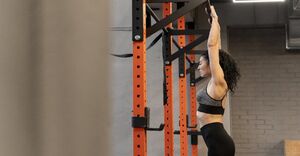
Master the Swing: The Ultimate Guide to Kettlebell Swing Techniques for Beginners
Looking to spice up your workout routine? Look no further than the kettlebell swing.
In this ultimate guide, we will cover everything you need to know about this dynamic exercise. From the basics of proper technique to common mistakes to avoid, we’ve got you covered.
Whether you’re a beginner looking to master the swing or a seasoned pro looking to refine your form, this article is for you. So grab your kettlebell and get ready to swing your way to a stronger, fitter you.
What Is a Kettlebell Swing?
A Kettlebell Swing is a fundamental exercise in kettlebell training, suitable for beginners looking to improve their fitness levels. This ultimate guide to kettlebell swings will help individuals understand the technique, benefits, and variations of this powerful workout.
Kettlebell swings are dynamic movements that engage multiple muscle groups simultaneously, making them a time-efficient option for those with busy schedules. For beginners, mastering the proper form is crucial to prevent injury and maximize the benefits of this exercise. By incorporating kettlebell swings into your fitness routine, you can enhance cardiovascular endurance, build core strength, and improve overall stability. Kettlebell swings are known for their ability to increase explosive power and develop functional strength, making them a valuable addition to any strength training program.
Why Should You Start Doing Kettlebell Swings?
Incorporating kettlebell swings into your workout routine offers numerous benefits, including improved muscle activation, enhanced power, and overall strength. Beginners can experience the positive impact of kettlebell movements on their fitness journey.
The dynamic, full-body movement of kettlebell swings engages multiple muscle groups simultaneously, providing a comprehensive workout. This not only helps in building functional strength but also improves cardiovascular fitness. The explosive nature of the swing movement helps in developing power and explosiveness, which can significantly enhance athletic performance.
For beginners, kettlebell swings are a great introduction to strength training, as they are relatively simple to learn and can be adapted to different fitness levels. Incorporating kettlebell swings into your routine can add variety and intensity, making your workouts more effective and enjoyable.
The Basics of Kettlebell Swing Technique
Mastering the basics of kettlebell swing technique involves understanding proper form, correct grip on the kettlebell handle, and the mechanics of the swing movement. Exploring different variations can help individuals achieve proficiency in this dynamic exercise.
A crucial aspect of perfecting the kettlebell swing is maintaining a strong neutral spine throughout the movement. By hinging at the hips, rather than bending at the waist, you engage the posterior chain effectively. Focus on driving the hips forward forcefully to generate momentum and swing the kettlebell smoothly. Pay attention to the handle grip, ensuring a firm grip without over-gripping to prevent fatigue in the forearms.
Practicing hip power and control will enhance your ability to execute swings with proper technique and efficiency.
Proper Grip and Stance
Achieving the correct kettlebell position and grip is crucial for maintaining control and ensuring safety during swings. The grip on the kettlebell handle should be firm but not overly tight to allow for smooth movement execution.
When performing kettlebell swings, your stance plays a critical role in distributing the weight efficiently and preventing injury. Ensure your feet are shoulder-width apart, with toes slightly pointing outward. Maintain a slight bend in your knees and hinge at the hips while keeping your back straight. This alignment will not only maximize power generation but also safeguard your lower back. Engaging your core muscles throughout the exercise provides stability and protects your spine. Remember, proper form is key to reaping the full benefits of kettlebell swings while minimizing the risk of strain.”
Hip Hinge Movement
The hip hinge movement is a foundational aspect of the kettlebell swing technique, emphasizing the engagement of hip power to generate momentum. Mastering this movement is essential for executing powerful and efficient swings.
Proper hip hinge technique involves maintaining a neutral spine, pushing the hips back while keeping the chest up. By driving the hips forward explosively and actively engaging the glutes, the power generated is transferred smoothly to the kettlebell swing. Initiating the movement from the hips not only enhances the effectiveness of each swing but also minimizes the strain on the lower back.
To improve your hip hinge, focus on practicing proper form with a lighter kettlebell before gradually increasing weight. Consistent practice and feedback from a qualified trainer can help you refine your hip hinge technique for optimal performance.
Explosive Hip Thrust
Executing an explosive hip thrust is key to maximizing the effectiveness of kettlebell swings, utilizing the hip hinge movement to drive the kettlebell upward. This dynamic action engages core muscles and enhances power output.
To execute this technique correctly, focus on pushing your hips forcefully forward while maintaining a strong core and straight back. The explosive hip thrust should generate power from the glutes and hamstrings, propelling the kettlebell in a smooth arc. Remember to keep your shoulders relaxed and let the momentum flow naturally from the hip thrust. Proper form not only ensures maximum power generation but also reduces the risk of injury.
Practice controlled movements initially to establish the correct mechanics before adding speed and intensity.
Controlled Arm Movement
Maintaining controlled arm movement during kettlebell swings is essential for shoulder health and optimal muscle activation. Proper shoulder engagement ensures stability and efficient transfer of power throughout the swing motion.
To enhance stability and prevent injury, it is crucial to keep the shoulders pulled back and down, away from the ears. This alignment helps to activate and strengthen the surrounding muscles, such as the upper back and rotator cuff.
Maintaining a straight wrist position throughout the swing will further protect the shoulder joint and optimize power generation. By focusing on these key points, individuals can not only improve their kettlebell swing technique but also promote long-term shoulder health and overall performance.
Common Mistakes to Avoid When Doing Kettlebell Swings
When performing kettlebell swings, it’s crucial to avoid common mistakes that can hinder progress and increase the risk of injury. Implementing key tips can help individuals correct their form and optimize the effectiveness of their swing workouts.
- One prevalent mistake to steer clear of is rounding the back during the swing, as this can strain the lower back and reduce the engagement of the core muscles. To remedy this issue, focus on maintaining a flat back throughout the movement by engaging the core and hinging at the hips correctly.
- Another common error is using the arms excessively to lift the kettlebell, which can lead to shoulder strain. Instead, drive the movement from the hips and generate power from the lower body, allowing the arms to act as a natural extension.
By practicing these adjustments and paying attention to form, individuals can achieve a more efficient and safer kettlebell swing routine.
Rounding the Back
One common mistake to avoid during kettlebell swings is rounding the back, as it can lead to strain and injury. Maintaining a strong and neutral spine throughout the movement is crucial for preventing potential back issues.
By keeping the spine in a neutral position, the load is distributed more efficiently and the risk of injury decreases. To maintain proper spinal alignment, focus on engaging the core muscles and keeping the chest up throughout the movement. It is important to hinge at the hips and not rely solely on the lower back for power. If you find yourself rounding your back during kettlebell swings, take a step back and practice with a lighter weight until you can perform the movement with correct form. Remember, prioritizing spinal health in kettlebell swings is essential for your overall safety and long-term fitness goals.
Using the Arms Instead of the Hips
Another common mistake in kettlebell swings is relying too heavily on the arms rather than engaging the hips. Proper hip activation is essential for generating power and momentum in each swing, enhancing the overall effectiveness of the exercise.
When you engage your hips correctly, you tap into the body’s powerful posterior chain, which includes the glutes, hamstrings, and lower back muscles. By initiating the movement with a strong hip hinge and thrusting your pelvis forward explosively, you allow these larger muscle groups to do the heavy lifting, rather than straining your arms.
To improve hip activation, focus on driving your hips forward forcefully at the top of the swing, squeezing your glutes at the top, and actively resisting the urge to pull with your arms. Remember, the power comes from the hips!
Not Engaging the Core
Failing to engage the core muscles during kettlebell swings is a common error that can limit the exercise’s effectiveness. Proper core activation enhances stability, power output, and muscle engagement, contributing to a more efficient workout.
When the core is properly engaged, it acts as the body’s center of strength, transferring power from the lower body through to the upper body. This not only increases the effectiveness of each swing but also helps in preventing injury by stabilizing the spine and pelvis.
Activating the core muscles also improves balance and coordination, allowing for smoother movement patterns and better control over the kettlebell. To enhance core stability during swings, focus on bracing your core as if preparing to be punched, maintaining a neutral spine, and breathing consistently throughout the movement.
Tips for Improving Your Kettlebell Swing Technique
Enhancing your kettlebell swing technique requires focused practice and attention to detail. Incorporating specific tips can help individuals refine their form, increase efficiency, and maximize the benefits of kettlebell training.
- One essential tip is to ensure proper alignment of your body throughout the movement. Maintaining a strong core and engaging your glutes can help generate power and prevent injury.
- Another key aspect is mastering the hip hinge motion, which is crucial for a smooth and effective swing. Focus on the timing of your hip thrust to propel the kettlebell forward and upward.
- Practice proper breathing techniques to synchronize your breath with each swing, aiding in stability and endurance. Overcoming challenges like overextending the back or relying solely on arm strength requires mindfulness and gradual adjustments.
Practice with a Lighter Weight
Starting with a lighter kettlebell weight when practicing swings allows individuals to focus on mastering technique before progressing to heavier loads. Building strength gradually and ensuring proper form are key aspects of effective skill development.
This gradual approach aids in refining movement patterns and muscle engagement, ultimately enhancing performance and reducing the risk of injury. By starting light, individuals can ingrain proper habits and improve their coordination and control.
As proficiency increases, one can then progressively increase the weight in small increments to continue challenging themselves while maintaining sound technique. This method not only optimizes strength gains but also fosters a deeper understanding of the movement, leading to long-term progress and proficiency in kettlebell training.
Focus on Form Over Repetitions
Prioritizing form over repetitions in kettlebell swings is essential for building endurance, preventing injury, and optimizing muscle engagement. Emphasizing correct form from the outset sets the foundation for long-term success in kettlebell training.
By focusing on proper technique, individuals can effectively target the intended muscle groups while reducing the risk of overuse injuries. Maintaining a neutral spine, engaging the core, and utilizing a hip-hinge movement pattern are key elements to pay close attention to during each swing. In addition to enhancing muscle strength and endurance, maintaining correct form throughout the workout also helps in developing better overall body coordination and balance. Consistency in form not only ensures a more efficient workout but also promotes gradual progression in strength and performance.
Film Yourself for Feedback
Recording your kettlebell swing workouts and reviewing the footage can provide valuable feedback on form, technique, and endurance. This proactive approach allows individuals to identify areas for improvement and track their progress effectively.
By analyzing your recordings, you can spot any deviations from the proper swinging technique and make necessary corrections. Visual feedback enables you to better understand your body’s movement patterns and make adjustments for enhanced performance.
Documenting your sessions allows you to observe your endurance levels over time, helping you tailor your workout plan for optimal results. To create a structured routine, consider incorporating various kettlebell exercises, adjusting weights as needed, and scheduling rest days to prevent overtraining.
Regularly filming and analyzing your workouts ensures that you stay focused on your goals and continue to progress steadily.
How to Incorporate Kettlebell Swings into Your Workout Routine
Integrating kettlebell swings into your workout routine can enhance its effectiveness by providing a full-body workout that targets multiple muscle groups. Whether used as a warm-up exercise, part of a circuit training routine, or a standalone workout, kettlebell swings offer versatile fitness benefits.
The dynamic nature of kettlebell swings allows for engaging the core, shoulders, back, and legs simultaneously. By mastering proper form and technique, individuals can experience improvements in strength, endurance, and overall functional fitness.
Incorporating variations such as single-arm swings or alternating swings can add complexity and challenge to the exercise, further enhancing its effectiveness. To structure a comprehensive workout plan, consider combining kettlebell swings with other compound movements like squats or lunges to work multiple muscle groups in one session. This diversity in training approach can prevent plateaus and keep workouts engaging and effective.
As a Warm-up Exercise
Using kettlebell swings as a warm-up exercise offers beginners an opportunity to activate muscles, increase heart rate, and prepare the body for more intense workout sessions. The dynamic nature of swings enhances flexibility, strength, and overall fitness levels.
By incorporating kettlebell swings into your warm-up routine, you not only engage multiple muscle groups simultaneously but also improve coordination and balance. This full-body movement helps in building core strength and improving posture, setting a strong foundation for your workout.
Beginners find kettlebell swings particularly beneficial as they provide a low-impact way to get the heart pumping and the body moving. The explosive nature of the swing movement also aids in developing power, speed, and agility, making it an ideal exercise to kickstart your fitness journey.
In a Circuit Training Workout
Including kettlebell swings in a circuit training workout can elevate strength, endurance, and cardiovascular fitness. The high-intensity nature of swings complements other exercises in the circuit, providing a comprehensive training stimulus for overall physical development.
The explosive nature of kettlebell swings engages multiple muscle groups simultaneously, leading to improved power and coordination. This exercise also helps in enhancing core stability and grip strength, which are vital for performing various movements effectively.
When incorporated strategically within a circuit routine, kettlebell swings can elevate heart rate significantly, promoting cardiovascular health and fat burning. To structure an effective circuit, alternate kettlebell swings with exercises that target different muscle groups to allow for adequate recovery between sets while maintaining a high training intensity throughout the session.
As a Standalone Workout
Utilizing kettlebell swings as a standalone workout can promote fat loss, muscle strength, and endurance. This focused approach allows individuals to tailor their training to specific fitness goals while reaping the benefits of a challenging and effective kettlebell routine.
By incorporating kettlebell swings into your regimen, you engage multiple muscle groups simultaneously, leading to enhanced calorie burn and improved cardiovascular fitness. Consistency in performing these dynamic movements can help in developing stronger core muscles, boosting overall stability and balance.
To optimize the effectiveness of your kettlebell workouts, consider varying the intensity by adjusting the weight of the kettlebell and the number of repetitions. This customization can help target different aspects of strength and endurance, allowing for a well-rounded and progressively challenging workout routine.




No Comments